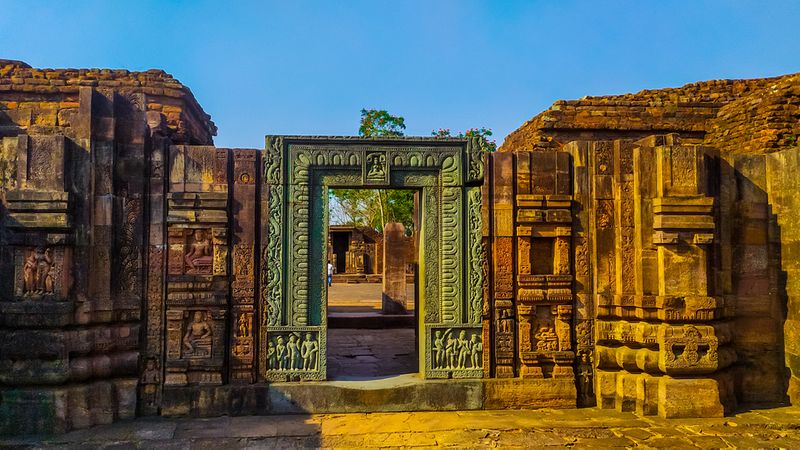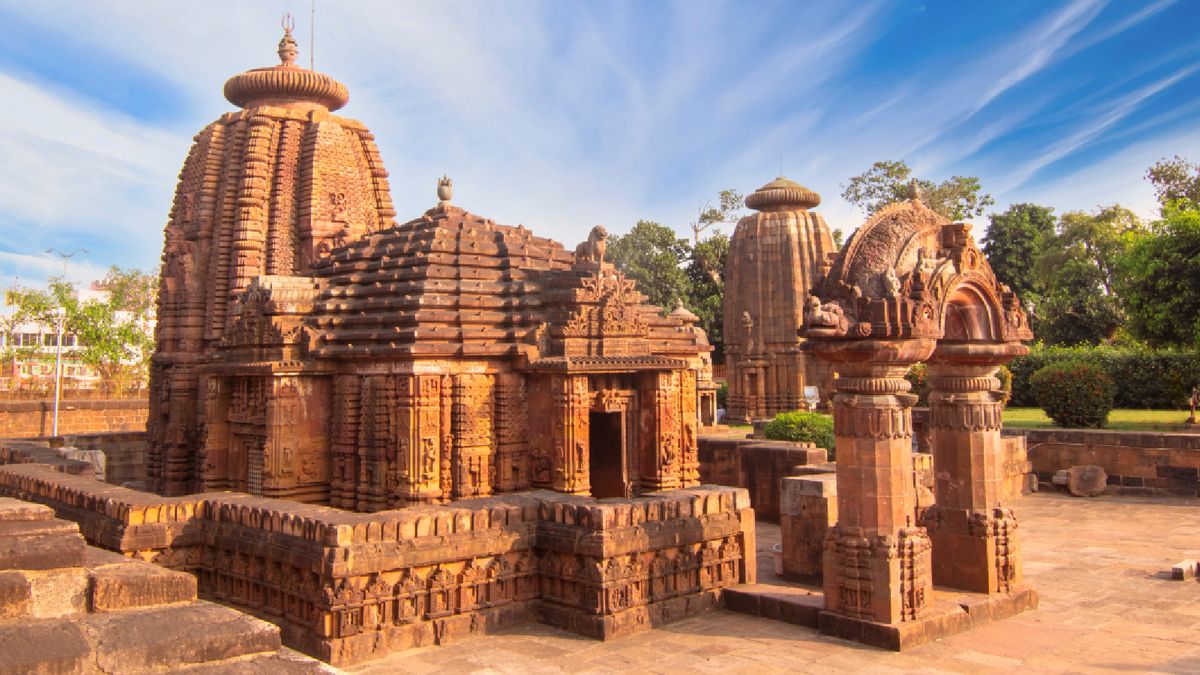2023 is going to be all about slow travel and discovering lesser-known destinations. The Diamond Triangle in Odisha is one such place that has evaded the tourist eye for too long. Also known as the Golden Triangle of Odisha, it narrates the history of Buddhism in India and dates back to the Mauryan empire in 300 BC. Not many know but Kalinga (as Odisha was known then) witnessed Emperor Ashoka’s last-ever battle. Noticing the ruin and destruction, he decided to accept non-violence and preach Buddhism in Odisha as a way of life. The three temples of Ratnagiri, Lalitgiri and Udayagiri are reminiscent of a time in history that changed its course forever.
The legacy of Buddhism
Centuries later, Odisha continues to be one of the very few places where Buddhism continues to be practised. This can be seen through the preserved religious sites that dot the entire state. The most prominent of them is Dhauli - the place where King Ashoka gained insight into his actions. Just a stone’s throw away from Dhauli lays the Diamond Triangle - a collection of three hills with sacred remnants of Buddhist temples. It wasn’t until the late 20th century that archaeologists dug up stories at this golden triangle of Odisha. Situated about 100 km from Bubhaneshwar, this Diamond Triangle in Odisha has a lot to tell.
Why is it called the Diamond Triangle?

Many people believe that the Diamond Triangle in Odisha gets its name from the triangular shape that the hills create. They are all located at equal distances from each other and it would make sense to assume that. However, according to archaeologists and historians, the Buddha triangle gets its name from the Vajrayana sect that was prevalent in these regions. The word Vajramani, derived from Sanskrit, refers to a diamond. Vajrayana or Vajrajana, a modification of this word was used to describe the ‘conduit of diamonds’. However, alternatively, another theory proposes that the Sanskrit word vajra could be translated to thunderbolt as well. That said, the Vajrayana sect preached an ‘indestructible’ form of Buddhism known as the Tantric.
Tantric Buddhism was majorly practised during the 5th century and was led by a Lama. It gained popularity and following in Tibet and a large part of eastern India. The bodhisattvas, who embark on their journey towards enlightenment partake in practices that channel their divine energy. Their goal is to use their knowledge for the well-being of everyone around them. So while you visit the Diamond Triangle, keep in mind the spirituality practised there gave the place its name. The Buddhists saw themselves as conduits of thunder and diamonds on a mission to make the world a kinder place. The relics found are indicative of the prevalence of Buddhism in Odisha.
Lalitgiri
This site is the closest to Bubhaneshwar and it would make sense to start here if you plan on covering all three of them. Book a cab that will take you around to avoid any waiting around for public transport. Lalitgiri is believed to be the oldest of the three sites in the Buddha triangle. Apparently, it dates back to 100 AD and was the only place along India’s Eastern coast where Lord Buddha’s casket was dug out. Along with this, archaeologists also found remnants of the Maha Stupa which has a unique build as opposed to others that have been found so far. Excavations of the casket have also revealed what appears to be a set of teeth which are now kept in the museum there. Apart from that, there is also a Chaitya Hall that adds to the collection of Buddhist heritage in Lalitgiri. Needless to say, after you have toured the hill a visit to the museum is a must for better insight into the past. Amongst the three sites, Lalitgiri is the most venerated for the Maha Stupa that was recovered.
Udayagiri
After Lalitgiri, head to Udayagiri. It is located about 10 km from the former and isn’t more than a 20-minute drive away. Amongst the three, this Buddhist site is believed to be the largest. You need to take the steps to reach the hill that overlooks the magnificent Brahmani River. The panoramic view is breathtaking and representative of the unacknowledged natural beauty of the Odia landscape. In Udayagiri the Buddhist ruins are scattered all over the neighbouring hills. There is something to see at every turn and step. However, the most prominent relic is the Vajrayana Stupa which is believed to be one of a kind. Don’t forget to explore the monasteries and the apsidal temple here that are like a swift walk back in time. Their intrinsic architecture and rustic rock structures are a sight to behold for any history-lover.
Ratnagiri
Ratnagiri is about 12 kms from Udayagiri. It has one of India’s largest monasteries that dates back to 1 millennium CE. The monastery is replete with two floors of monastic cells, a temple and memorials of Vajrayana and Mahayana. This jewel of the golden triangle of Odisha runs around a central courtyard that has Buddha shrines on display. Apart from that, the doorways of the monastery display some extremely skilled carvings worth taking a look at. Historians also believe that Ratnagiri and Udayagiri together constituted a large university. The primary education given here was that of theology and philosophy. Lastly, don’t forget to take a walk through the huge museum in Ratnagiri. You can find all the fragile excavations from the Buddha triangle kept here for safekeeping, research and education.
Other things to do in the Diamond Triangle of Odisha
The three Buddhist hills aren’t the only places of interest in the Diamond Triangle. While you are there, you cannot miss Dhauli and the site of the Kalinga Battle. Langudi Hill is another place that has recently revealed a lot more secrets and stories. Apart from the stupas of the Buddha, archaeologists have also found a statue of Emperor Ashoka himself. Langudi also contributed to the large university, potentially believed to have been named Pushpagiri. Sit along the banks of the river Daya and imagine a great emperor falling to his knees in the wake of the destruction around him. It was here that the bloodied waters brought him back to his senses and made him take a vow that changed the course of history. Apart from that, Dhauli is also home to a rock-cut elephant statue, one of the oldest Buddhist creations. It has its own story to tell, one which you can only revel in while you are there.
Things to know of when travelling to the Diamond Triangle of Odisha
- The closest airport is in Bhubaneswar (BBI) which is about 100km away from Lalitgiri, the closest of the three hills.
- If you are planning on travelling to Odisha by train, the nearest railway station is in Cuttack and Bhubaneswar.
- There are buses that run between Cuttack and the Golden Triangle of Odisha but they are infrequent and unreliable.
- You need private transport to be able to commute between the three hills.
- Apart from Udayagiri, Lalitgiri and Ratnagiri, you can also head to Jajpur. The small town is located north of the Golden Triangle of Odisha. It is home to the famed temple of Shaktipitha-Bajraj.
- There may not be any eateries at the Diamond Triangle of Odisha so don’t forget to pack your meals and plenty of water with you. If you come across the tribal food of Odisha, do indulge.
- If you are starting out from Bhubaneshwar, head out early in the morning to catch the sunset from these hills. Also, it will give you plenty of time to explore without tiring yourself out.
If you are looking for places to visit in Bhubaneshwar, this is your sign. Odisha’s history is unparalleled when it comes to religious heritage, especially the legacy of Buddhism. From Hindu temples to Buddhist relics, the state is home to some of the most intricate architecture. Take a serene road trip back in time and don’t forget to pick up some handloom textiles from Odisha while you are there!
Disclaimer: The details mentioned throughout this blog are sourced from publicly accessible platforms. At Zeezest, we intend to share factual and verified information. Should there be any inconsistencies or variances in the information provided, please understand that these are entirely unintentional and not meant to mislead.


